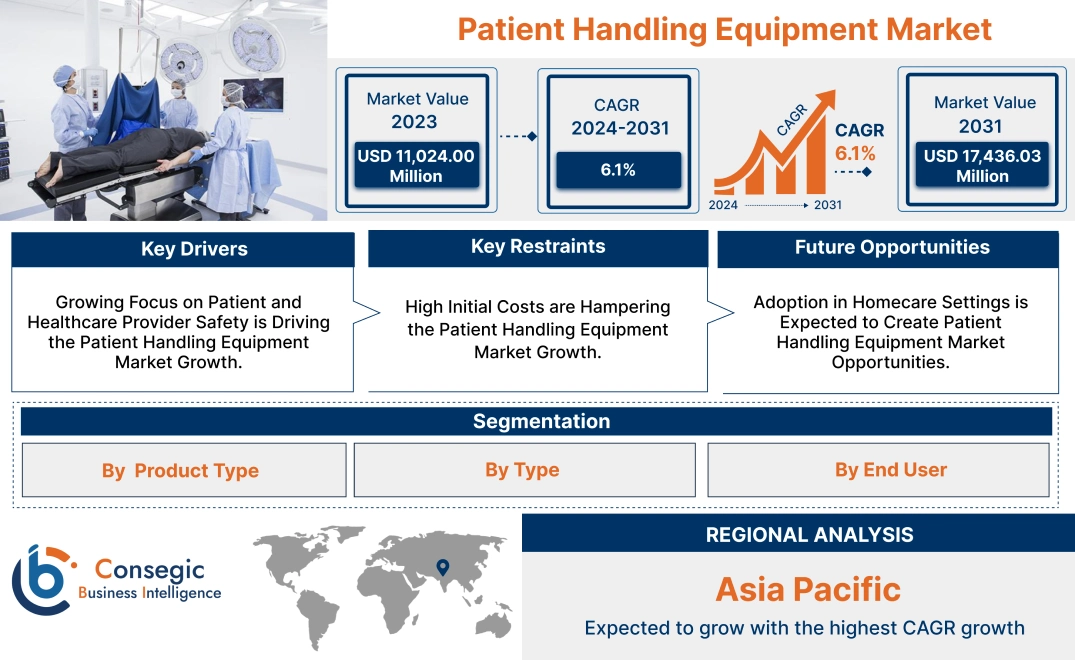- Summary
- Table Of Content
- Methodology
Patient Handling Equipment Market Size:
Patient Handling Equipment Market size is growing with a CAGR of 6.1% during the forecast period (2024-2031), and the market is projected to be valued at USD 17,436.03 Million by 2031 from USD 11,024.00 Million in 2023.
Patient Handling Equipment Market Scope & Overview:
Patient handling equipment refers to a wide range of equipments designed to assist in safely moving, transferring, and transporting patients. These equipment are crucial for ensuring the safety of both patients and healthcare providers, minimizing the risk of injuries during various medical procedures and daily care activities. Patient handling equipment encompasses a wide range of products including patient transfer devices, medical beds, ambulatory aids, and bathroom safety equipment among others. These devices are categorized as mechanical and non-mechanical. They are extensively utilized for acute care, critical care, and long-term care among others. Owing to the spectrum of applications patient handling equipment serve a crucial role in hospitals, homecare settings, ambulatory surgical centers, rehabilitation centers, and long-term care facilities.
Patient Handling Equipment Market Dynamics - (DRO) :
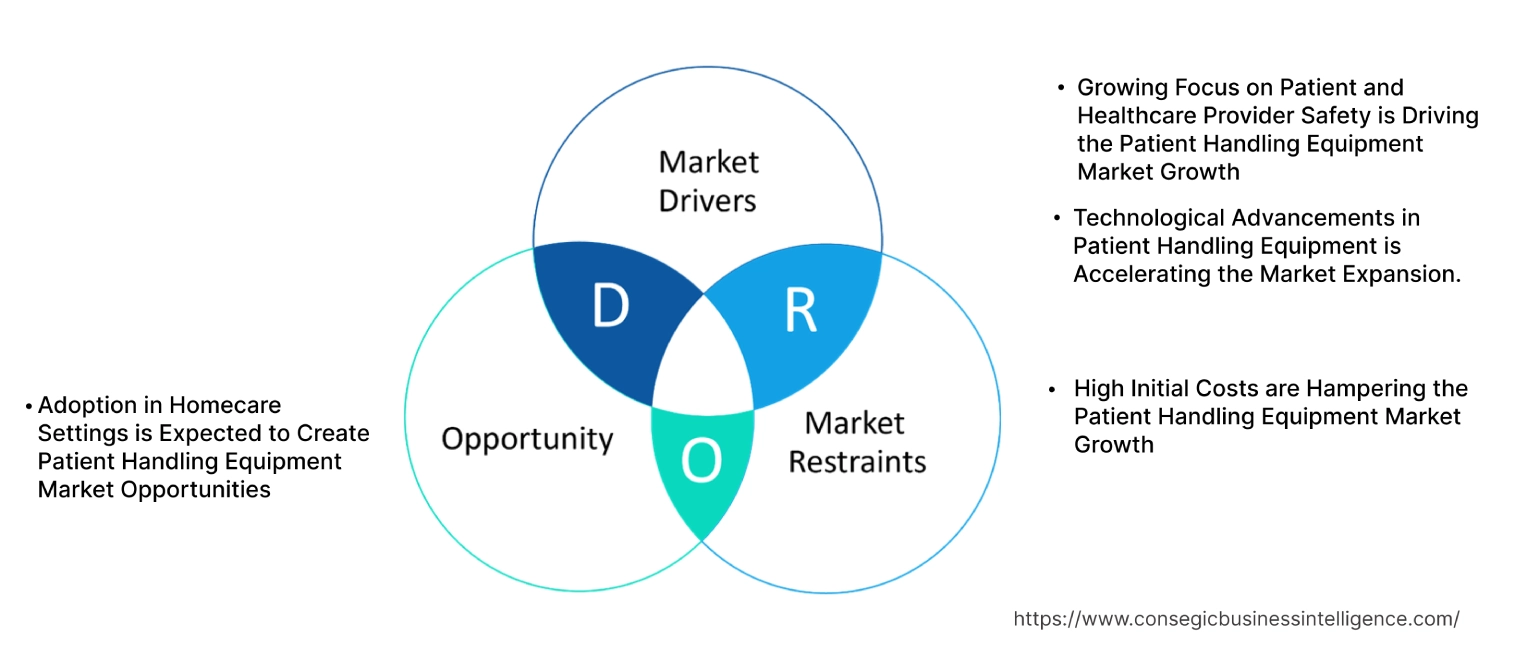
Key Drivers:
Growing Focus on Patient and Healthcare Provider Safety is Driving the Patient Handling Equipment Market Growth.
Patient safety and healthcare provider safety are paramount concerns in healthcare settings. Manual patient handling results in serious injuries for both patients and healthcare workers, including musculoskeletal disorders, back injuries, and falls. To mitigate these risks, healthcare facilities are taking initiatives to adopt patient handling equipment.
- For instance, in May 2023, SSM Health Illinois Introduced the LIFTsmart Program supporting safe movement for patients and team members. The program includes lifts, lateral transfers and repositioning, slings, and standing and raising aids. The state-of-the-art equipment provides key team members with the tools, skills, and knowledge to enable safe and efficient working. The program aims to assist in reducing patient falls, bedsores, length of patient stay, and staff injuries associated with patient handling.
By minimizing manual lifting and transferring tasks, these devices reduce the risk of falls and injuries for both patients and healthcare workers. Specialized mattresses and cushions help prevent pressure ulcers and skin tears, enhancing patient comfort. Automated patient handling equipment streamlines workflows and reduces physical strain on healthcare providers, improving efficiency and job satisfaction.
Thus, these equipments contribute to a safer and more efficient healthcare environment. As healthcare facilities continue to prioritize patient safety and worker well-being, the demand for advanced patient handling solutions is rising.
Technological Advancements in Patient Handling Equipment is Accelerating the Market Expansion.
Technological advancements are significantly fueling the patient handling equipment market, leading to safer, more efficient, and patient-friendly solutions. A few of the advancements include smart patient handling equipment, equipped with IoT (Internet of Things) integration and sensor-based systems, enabling real-time monitoring and automated tasks, reducing the physical strain on healthcare workers and improving patient safety.
Ergonomic designs, such as intuitive controls, adjustable features, and lightweight materials, enhance user experience and minimize the risk of injuries. Advanced materials, such as antimicrobial coatings and pressure-relieving surfaces, enhance hygiene and comfort. The development of technologically advanced equipment facilitates patient mobility and minimizes the risk of clinician injuries.
- For instance, in June 2023, Baxter International Inc. announced the launch of its new Hillrom Progressa+ bed for the ICU. Progressa+ provides in-bed percussion, vibration, and continual lateral rotation therapies designed to help reduce pulmonary complications associated with immobility. It features enhanced support surfaces designed to help support optimal skin protection and wound healing. A new top cover allows for easier cleaning. Used in conjunction with an integrated lift system, Progressa+ helps the care team support patient mobility protocols while minimizing the risk of clinician injury.
Telehealth integration further empowers healthcare professionals by enabling remote monitoring and virtual training, optimizing patient care. Robotic-assisted devices automate lifting and transferring tasks, reducing the physical strain on healthcare workers and improving patient safety. By adopting these technological innovations, the patient handling equipment market is poised to continue its growth.
Key Restraints :
High Initial Costs are Hampering the Patient Handling Equipment Market Growth.
The high initial cost of patient handling equipment is a significant restraint for the market. Advanced equipment, such as electric lifts, specialized slings, and advanced medical beds, are expensive to purchase and maintain. This serves as a major barrier for smaller healthcare facilities, particularly in developing countries, where budgets may be limited. Additionally, the cost of training healthcare staff to use the equipment effectively adds cost to the overall expenditure. Moreover, equipment used in patient handling must adhere to stringent safety and regulatory standards. Compliance testing and certification processes become time-consuming and expensive, adding to the overall cost of the product.
The high initial cost of this equipment significantly hinders their adoption. Smaller healthcare facilities, particularly those with limited budgets, are unable to afford the upfront investment, leading to continued reliance on manual handling techniques. Furthermore, the high cost discourages healthcare facilities from investing in the latest advancements in patient handling technology, limiting innovation and improvement in patient care.
Future Opportunities :
Adoption in Homecare Settings is Expected to Create Patient Handling Equipment Market Opportunities.
The patient handling equipment market is poised for significant growth in upcoming years owing to the increasing demand for home healthcare services. Homecare refers to healthcare or supportive services provided in a person's home. It caters to individuals who are ill, disabled, elderly, or recovering from surgery. The rising prevalence of chronic diseases has increased the demand for home care services. Additionally, healthcare reform initiatives, including the shift to outpatient care and expanded insurance coverage, have made home care more accessible and affordable.
As more individuals opt for home-based care, the need for safe and efficient patient handling solutions becomes paramount. The development of advanced equipment, such as powered lifts and mobile patient lifts, makes it easier for caregivers to safely and efficiently handle patients.
- For instance, in July 2024, Top Medical Mobility (TMM), a home medical equipment (HME) and mobility aid supplier introduced a new line of Hoyer lifts and patient lift transfer chairs designed for home use. These hydraulic lift solutions aim to alleviate the physical strain on caregivers by providing hydraulic assistance for seamless patient transfers. As home-based care gains popularity, TMM's innovative products are poised to revolutionize patient handling and transfer practices.
Thus, the growing requirement from homecare settings is expected to propel the patient handling equipment market expansion in forecast years.
Patient Handling Equipment Market Segmental Analysis :
By Product Type:
Based on product type, the market is bifurcated into patient transfer devices, medical beds, mobility aids, bathroom safety equipment, and others.
Trends in the Product Type:
- Focus on customizable and ergonomic designs to cater to diverse patient needs and preferences.
- Focus on lightweight and portable devices to improve ease of use and portability.
- Increasing adoption of smart beds equipped with sensors and monitoring capabilities for remote patient care.
The medical beds segment accounted for the largest market share in 2023.
- Medical beds are specialized hospital beds designed to provide optimal comfort, support, and functionality for patients with limited mobility. These beds are essential in various healthcare settings, such as hospitals, nursing homes, and home healthcare.
- They offer a range of features, including adjustable height, pressure relief surfaces, integrated positioning systems, side rails, built-in scales, and integrated monitoring systems. These features help to improve patient comfort, reduce the risk of pressure ulcers, and facilitate efficient patient care.
- The rising geriatric population and the increasing prevalence of chronic illnesses, such as diabetes and arthritis, are driving the requirement for medical beds. Furthermore, advancements in technologysuch as smart beds with built-in sensors and monitoring capabilities are further driving the trajectory of the segment.
- These innovative beds track vital signs, alert healthcare providers to potential issues, and improve patient outcomes. Furthermore, the increasing emphasis on patient comfort and safety has led to the development of more ergonomic and user-friendly medical beds.
The mobility aid segment is expected to grow at the fastest CAGR over the forecast period.
- Mobility aids are devices designed to assist individuals with mobility impairments in walking and performing daily activities. These devices include wheelchairs, walkers, canes, and crutches among others. These devices provide support, stability, and independence, enabling individuals to maintain an active lifestyle.
- The increasing incidence of neurological disorders and rising healthcare costs are driving the requirement for mobility aids. Moreover, advancements in technology and the development of lightweight, foldable, and customizable ambulatory aids are contributing to the trajectory of this segment.
- For instance, in November 2024, Paiseec, a brand operating in innovative mobility solutions, launched W3, a 3-in-1 device that enhances the mobility experience for wheelchair users. The W3 electric wheelchair is specifically designed to cater to the varied needs of wheelchair users across different environments. The W3 seamlessly switches between three modes: a power wheelchair for daily mobility, an intelligent transport device, and a rollator for extended use, thus embodying the versatility of a single device serving multiple purposes.
- Thus, as per the analysis, advancements in technology are expected to propel the trajectory of the segment in patient handling equipment market trends.
By Type:
- Based on the type, the market is bifurcated into mechanical and non-mechanical.
Trends in the Type:
- Rising adoption of robotic patient handling systems.
- The growing popularity of ergonomic patient handling devices.
The mechanical segment accounted for the largest market share in the year 2023 and is also expected to grow at the fastest CAGR over the forecast period.
- Mechanical patient handling equipment uses a powered mechanism such as a motor or hydraulics to lift and transfer patients, significantly reducing physical strain on caregivers.
- Patient lifts, patient transfer slings, and electric beds are some of the mechanical equipment.
- These types of equipment offer numerous advantages making them increasingly preferred in healthcare settings. By utilizing mechanical power, these devices significantly reduce the physical strain on healthcare workers, minimizing the risk of musculoskeletal injuries.
- Additionally, mechanical devices streamline the patient handling process, saving time and optimizing workflow, allowing healthcare professionals to focus on providing quality care.
- Owing to the benefits offered by mechanical patient handling equipment there is a growing focus on the development of technologically advanced products.
- For instance, in May 2022, Invacare announced the U.S. introduction of its Birdie Evo XPLUS, an innovative patient lift solution for the post-acute care setting. With its sleek and modern design, the Birdie Evo XPLUS provides innovative technology that helps maximize comfort and security when lifting or transferring a patient to or from a bed, chair, or floor.
- Thus, as per the analysis, the integration of mechanical equipment into healthcare settings offers significant benefits, enhancing patient care and improving the well-being of healthcare professionals that drive the segment in the patient handling equipment market trends.
By End User:
Based on end-users, the market is categorized into hospitals, homecare settings, ambulatory surgical centers, rehabilitation centers, long-term care facilities, and others.
Trends in the End User:
- Increasing demand for specialized equipment to handle bariatric and geriatric patients.
- Increasing number of outpatient procedures and shorter hospital stays.
The hospitals segment accounted for the largest market share of 42.18% in 2023.
- Hospitals require a wide range of equipment, including patient lifts, transfer slings, electric beds, and other devices to efficiently and safely move and position patients.
- The increasing number of elderly patients and the growing emphasis on patient safety & staff well-being are driving the requirement for advanced equipment for patient handling in hospitals. Moreover, the growing trend toward patient-centered care is further fueling the demand for comfortable and functional patient handling devices in hospital settings.
- Healthcare providers are increasingly recognizing the risks associated with manual patient handling. By providing proper equipment, such as patient lifts, and training staff on their safe and effective use, healthcare organizations are able to significantly reduce the incidence of injuries and improve patient care. Hence, hospitals are investing in the adoption of these equipment to reduce the risk of musculoskeletal injuries among healthcare workers and improve patient care.
- For instance, in June 2021, Henry Ford Hospital partnered with Atlas Lift Tech, Inc. and Arjo Diligent Clinical Consultants to launch a program aimed at enhancing the safety of patients and team members. The program, named Project Mobility includes the installation of active lifts, passive lifts, ceiling lifts, lateral transfer, and repositioning tools that will stay in each unit of Henry Ford Hospital.
- Thus, as per the analysis, hospitals hold a major share in the overall patient handling equipment market analysis.
The homecare settings segment is expected to grow at the fastest CAGR over the forecast period.
- Home care is the provision of medical treatment and assistive care by licensed professionals to individuals in their residences. This type of care is designed to help people who are aging, disabled, chronically ill, or recovering from a medical event to improve their quality of life while receiving healthcare services.
- As elderly individuals opt for home-based care, the requirement for equipment used for patient handling in-home use is growing. Devices such as wheelchairs, walking aids, transfer aids, lifting slings, and bath hoists help caregivers safely and efficiently manage patients at home.
- Moreover, the rise in home care services fuels the requirement for patient-handling devices. Demographic shifts, such as the aging population and rising prevalence of chronic diseases, have increased the need for home care services. As per the analysis, the increasing availability of homecare services is expected to propel the adoption of these equipment creating growth of the segment in patient handling equipment market share.
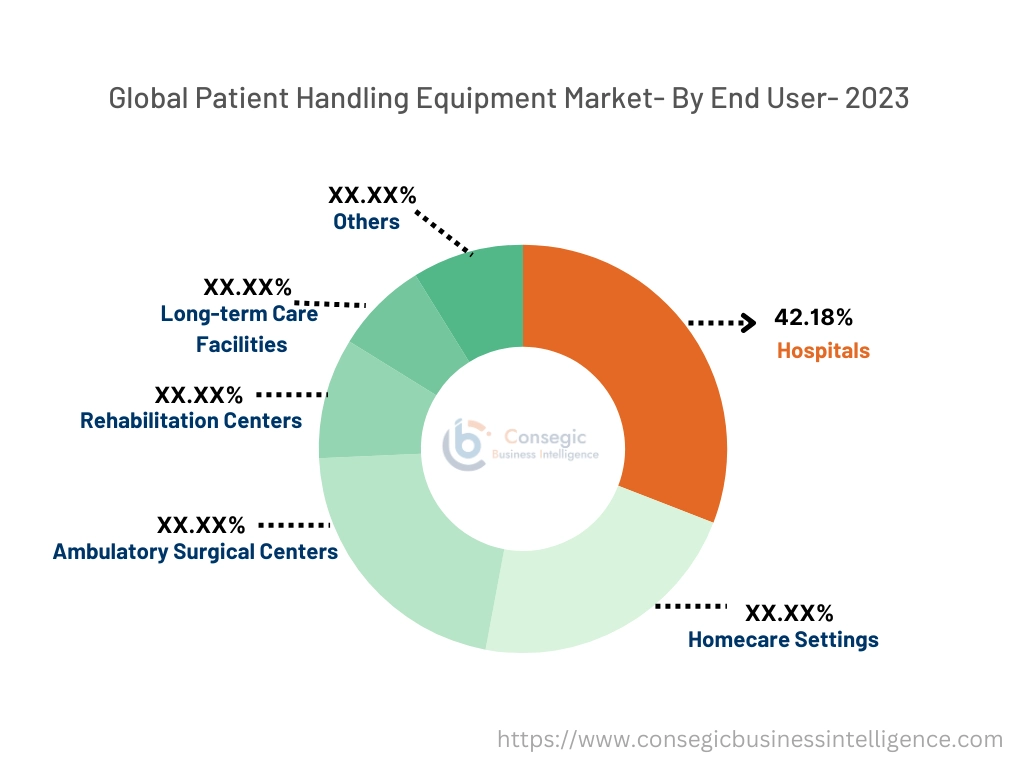
Regional Analysis:
The regional segment includes North America, Europe, Asia Pacific, the Middle East and Africa, and Latin America.
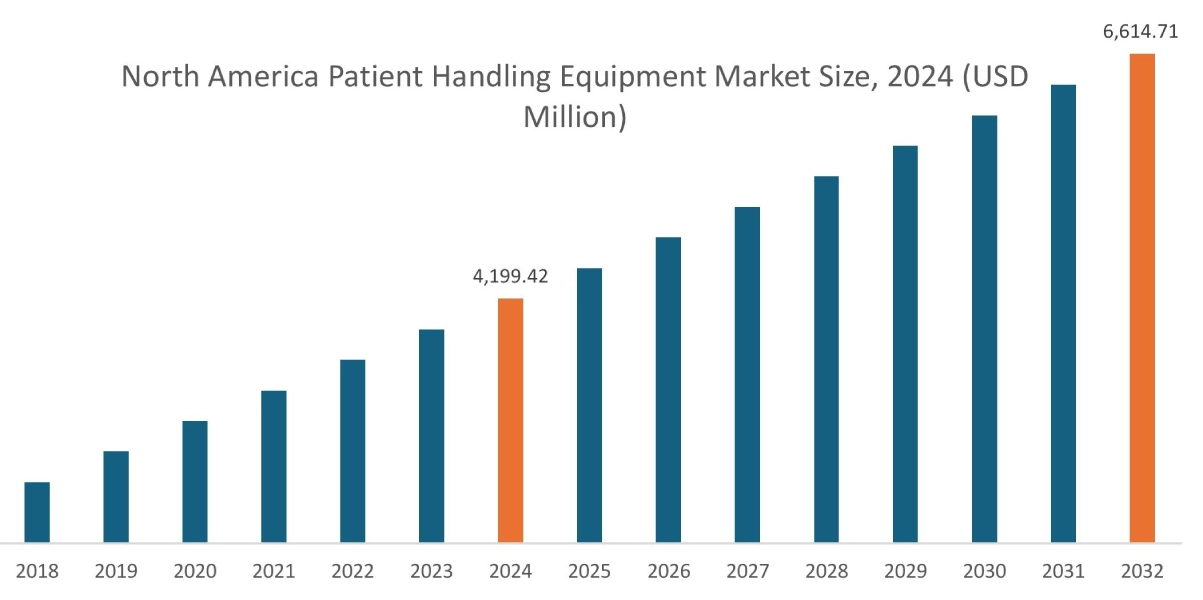
In 2023, North America accounted for the highest market share at 36.85% and was valued at USD 4,062.34 Million and is expected to reach USD 6,414.71 Million in 2031. In North America, the U.S. accounted for the highest share of 68.20% during the base year of 2023.
The North American region is a major market for patient handling equipment, driven by factors such as the increasing prevalence of chronic diseases, and stringent regulations for patient safety and worker well-being. The United States is a major market with a strong focus on technological advancements and innovative product development. Government bodies across the region are also taking the initiative to improve patient and healthcare provider safety.
- For instance, in September 2024, the Biden-Harris Administration announced progress and new commitments to improve patient and healthcare workforce safety. Under these commitments, the Agency for Healthcare Research and Quality (AHRQ) launched the National Action Alliance for Patient and Workforce Safety (NAA). On November 1, NAA will deliver the first version of a National Healthcare Safety Dashboard to transparently monitor the nation’s progress toward eliminating the highest priority preventable patient and workforce harms across all settings, beginning with hospitals. This creates the requirement of patient handling equipment for patient and healthcare workforce safety.
Additionally, the region's healthcare infrastructure, coupled with a growing emphasis on patient-centered care, has led to a significant requirement for advanced equipment for patient handling. Furthermore, the rising healthcare costs and the need for cost-effective solutions are driving the adoption of equipment for patient handling. By reducing the risk of injuries, improving efficiency, and enhancing patient outcomes, these devices contribute to significant cost savings in the long run. Thus, as per the analysis, a combination of the aforementioned factors and trends is driving the substantial rise in the North American patient handling equipment market share.
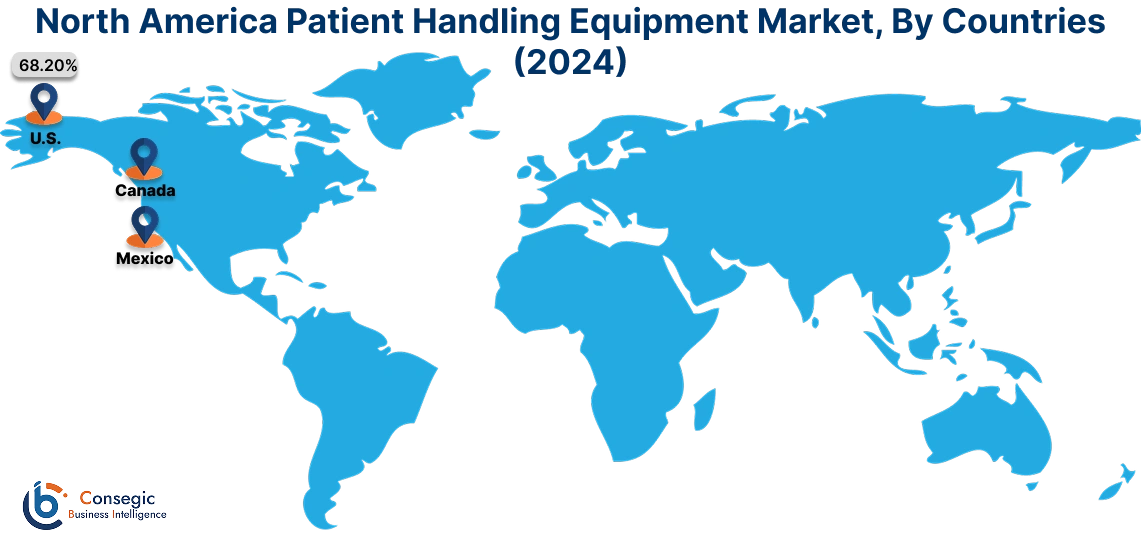
Asia Pacific is expected to grow at the fastest CAGR of 7.9% over the forecast period. The region is a rapidly growing market, driven by factors such as increasing geriatric populations, rapidly developing healthcare infrastructure, and growing awareness of patient safety and staff well-being. Countries like China, India, Japan, and South Korea are major contributors to this growth. The region's aging population, coupled with the increasing prevalence of chronic diseases, has led to a surge in the requirement for patient-handling equipment to assist with patient transfers, positioning, and mobility. Additionally, governments in the region are implementing regulations and guidelines to promote safe patient handling practices, further fuelling the patient handling equipment market expansion.
Europe is a significant player in the global patient handling equipment market demand, characterized by the increasing prevalence of chronic diseases and a strong focus on patient safety. Additionally, stringent regulations on patient handling practices and technological advancements in patient handling devices also contribute to market trajectory across the region. Europe boasts a well-established healthcare industry with a large number of hospitals, nursing homes, and rehabilitation centers. These facilities are increasingly adopting advanced equipment for patient handling to improve patient care and reduce the risk of injuries to both patients and healthcare workers. Moreover, the growing requirement for home care also creates the patient handling equipment market opportunity across Europe.
The Middle East and Africa (MEA) region is witnessing notable patient handling equipment market demand characterized by significant potential. The burgeoning healthcare sector in the Middle East is playing a pivotal role in the requirement for this equipment. This includes the establishment of new hospitals, clinics, and specialty centers, among others that heavily rely on equipment for patient handling to improve patient care and reduce the risk of injuries to both patients and healthcare workers. Additionally, the increasing healthcare spending is also contributing to market trends across the region. As healthcare systems in the region continue to modernize, the adoption of innovative patient handling solutions, including electric lifts, transfer slings, and specialized beds, is expected to accelerate.
As per the patient handling equipment market analysis, Latin America presents substantial growth driven by factors such as an aging population, increasing prevalence of chronic diseases, and growing healthcare infrastructure. Countries like Brazil and Mexico, with their large populations and expanding healthcare sectors, are major contributors to this growth. The increasing focus on patient safety and the need to reduce the risk of work-related injuries among healthcare workers are driving the requirement for advanced equipment for patient handling. As healthcare systems in Latin America continue to modernize, the adoption of innovative patient handling solutions, such as electric lifts, transfer slings, and specialized beds, is expected to accelerate. These factors collectively present a promising factor for healthcare providers and manufacturers to develop and deliver innovative patient handling solutions in Latin America.
Top Key Players & Market Share Insights:
The Patient Handling Equipment market is highly competitive with major players providing products to the national and international markets. Key players are adopting several strategies in research and development (R&D) and product innovation to hold a strong position in the global Patient Handling Equipment market. Key players in the Patient Handling Equipment industry include-
- Stryker (U.S.)
- Hillrom and Welch Allyn (U.S.)
- GF Health Products, Inc. (U.S.)
- Etac AB (Sweden)
- Guldmann (Denmark)
- Invacare Corporation (U.S.)
- Arjo (Sweden)
- Getinge (Sweden)
- Baxter (U.S.)
- Joerns Healthcare (U.S.)
Recent Industry Developments :
Product Launch:
- In July 2024, Top Medical Mobility (TMM), launched a new line of Hoyer lifts and patient lift transfer chairs designed for home use. These hydraulic lift solutions aim to alleviate the physical strain on caregivers by providing hydraulic assistance for seamless patient transfers.
- In May 2024, Küschall, renowned for its pioneering designs and use of state-of-the-art materials, unveiled a new Champion SL manual wheelchair, the Küschall Champion SL. Super light and rigid, the Champion SL blends the convenience of the first folding rigid chair, the Champion, with the premium, high-performance features of the KSL model.
- In June 2023, Baxter International Inc. announced the launch of its new Hillrom Progressa+ bed for the ICU. Key features include advanced therapy options to reduce pulmonary complications, improved support surfaces for optimal skin health, and an easy-to-clean design. Additionally, the integrated lift system promotes patient mobility while safeguarding healthcare workers.
- In May 2022, Invacare announced the U.S. introduction of its Birdie Evo XPLUS, an innovative patient lift solution for the post-acute care setting. With its sleek and modern design, the Birdie Evo XPLUS provides innovative technology that helps maximize comfort and security when lifting or transferring a patient to or from a bed, chair, or floor.
Partnership:
- In August 2022, Dozee, an Indian connected health device maker partnered with Midmark India, one of the biggest hospital bed manufacturers in South Asia, to launch a connected bed platform for non-ICU settings.
Patient Handling Equipment Market Report Insights :
| Report Attributes | Report Details |
| Study Timeline | 2018-2031 |
| Market Size in 2031 | USD 17,436.03 Million |
| CAGR (2024-2031) | 6.1% |
| By Product Type |
|
| By Type |
|
| By End-User |
|
| By Region |
|
| Key Players |
|
| North America | U.S. Canada Mexico |
| Europe | U.K. Germany France Spain Italy Russia Benelux Rest of Europe |
| APAC | China South Korea Japan India Australia ASEAN Rest of Asia-Pacific |
| Middle East and Africa | GCC Turkey South Africa Rest of MEA |
| LATAM | Brazil Argentina Chile Rest of LATAM |
| Report Coverage |
|
Key Questions Answered in the Report
How big is the Patient Handling Equipment market? +
In 2023, the Patient Handling Equipment market is USD 11,024.00 Million.
Which is the fastest-growing region in the Patient Handling Equipment market? +
North America is the fastest-growing region in the Patient Handling Equipment market.
What specific segmentation details are covered in the Patient Handling Equipment market? +
Product Type, Type, and End User segmentation details are covered in the Patient Handling Equipment market
Who are the major players in the Patient Handling Equipment market? +
Stryker (U.S.), Hillrom and Welch Allyn (U.S.) and Invacare Corporation (U.S.) are some of the major players in the market.
